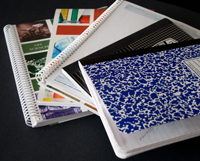Teaching Good Science and Engineering Habits: Keeping a Lab Notebook
Science and engineering projects often involve many steps, many trials, many materials, and may take many weeks. Help your students learn critical organization and recordkeeping skills by requiring a science project lab notebook!

The first step of the scientific method may be "Ask a Question," but the first step you might require before your students even think about questions or take the Topic Selection Wizard survey is to get a lab notebook. Keeping a lab notebook is an important part of the science, engineering, or research project process. With a lab notebook as a requirement for even science projects in the middle grades, students who keep a lab notebook gain valuable experience as they learn to organize their research, manage their time, and document all steps of a project.
With many science and engineering project assignments spanning a number of weeks, or even most of a semester, there are lots and lots of details that a student needs to remember about her project. From the project's initial conceptualization or invention sketches, to the exact materials purchased and the experimental design, to the day when a shoot first emerged in a plant biology project or a field of bacteria showed signs of antibiotic resistance, you want to encourage your students to write it all down.
Helping Keep Science Projects on Track
If left to sticky notes and student memory, a lot of important detail about a project may be lost or forgotten, including reasons behind certain changes, specific observations, solutions to problems encountered, and data collected. Students who use a lab notebook may find it much easier to write a final research report, prepare a classroom presentation, or put together a science fair project display board.
Science Buddies "Keep a Great Science or Engineering Project Notebook" resource offers great information to help your students get started using a lab notebook for a science project. By following the recommended tips and techniques, students can quickly get into the habit of documenting their science and engineering projects. They will stay more organized and be able to better negotiate the many phases of the project or of the scientific or engineering method. Plus, if your students are using lab notebooks, you can require check-ins at key points or dates in the process to ensure that everyone is on track, that projects are proceeding as planned, and to intervene or redirect if problems are detected.
Choosing a Lab Notebook
Part of the perennial school supplies market, there are many kinds of lab notebooks available. The standard composition book is a classic and inexpensive option. Its lined pages and durable cover make it an easy option for students, and this style of lab notebook can work well for tracking and organizing K-5 and middle school student projects. But there are other styles of lab notebooks available, some of which are specifically for science and engineering projects. (See our summary of lab notebook styles and recommended users.)
A line of specialty notebooks from Hayden-McNeil, for example, is designed to meet the needs of students working on science and engineering projects—and to make it even easier for teachers to oversee the lab notebook component. These notebooks feature carbonless duplicate pages so that each entry a student makes is also recorded on a duplicate page that can be removed and turned in. While having thirty or more students all turn in a lab notebook once a week can add up to an unwieldy pile of notebooks for a teacher, having students tear out and hand in "copies" of their notebook entries makes it easy and convenient to evaluate lab notebooks throughout the science project process. Even if the teacher evaluation is only a check that students are routinely and completely documenting their projects, the requirement can help ensure successful and on-time science and engineering project assignments.
Hayden-McNeil's duplicate lab notebooks come in a number of variations and formats. Lab notebooks are available for specific areas of science, including life science, environmental science, chemistry, and physics. In notebooks specific to an area of science, handy reference material for that area is conveniently located on the back cover and on the plastic divider (used when making a new entry). The notebooks come in both spiral-bound and hardbound versions, and are available in 50-page and 100-page formats. Other well-thought features include: numbered pages, quad-ruled paper, fields at the top and bottom for labeling and dating, and a blank table of contents for easy organization. Duplicate pages are clearly marked "copy" and are perforated for easy removal.
These specialty notebooks are available online at Amazon.com. Here are a few of the variations:
- Top bound, 50 carbonless duplicate sets
- Top bound, 100 carbonless duplicate sets
- Spiral bound, 100 carbonless duplicate sets
- Life Sciences, spiral bound, 70 carbonless duplicate sets
- Chemistry, top bound, 50 carbonless duplicate sets
- Organic Chemistry, spiral bound, 100 carbonless duplicate sets
Teachers and schools interested in purchasing carbonless duplicate lab notebooks can find additional information and request samples on the Hayden-McNeil website. (Hayden-McNeil does not sell directly to students or general users.)
How to Get Started?
If you haven't required a lab notebook as part of your science or engineering project assignments before, consider adding it as a requirement this year. Encourage your students to review the following Science Buddies resources. These resources offer easy-to-follow strategies that can help your students make the most of keeping a lab notebook:
- Science and Engineering Project Laboratory Notebooks: This resource, part of the Science Buddies Project Guide, introduces students to the kinds of laboratory notebooks that are available and helps them understand how to approach keeping a lab notebook, how to choose a lab notebook, what to do before making the first entry, and what to record in a science and engineering project lab notebook.
- Lab Notebooks: A supplement to the main Science Buddies Lab Notebook resource, this Science Buddies Blog entry contains additional tips, tricks, and suggestions for keeping a successful lab notebook.
The best way to help your students get into the habit of good recordkeeping and documentation is to clearly articulate your expectations. Do you want the pages numbered? Do they need to date each entry? Is ink required? With the mechanics clearly stated, encourage them to use their lab notebooks! Recording an entry each day for a period of days is one of the best ways to help them make utilizing the lab notebook part of their daily routine. Consider assigning initial brainstorming sessions as a lab notebook assignment to get them used to recording their notes in their lab notebooks. Pre-project assignments like this can also help familiarize students with your expectations and requirements for entries.
Teacher Giveaway: Share Your Lab Notebook Tips!
What tips do you recommend to students? What strategies do you find help them stay organized? What suggestions do you have for teachers who plan to require lab notebooks this year for the first time?
Email a comment to blog@sciencebuddies.org to share your best tip, strategy, or class assignment for using lab notebooks with K-12 students, and we will enter you in a drawing for specialty duplicate notebooks for your class (up to 30 notebooks), courtesy of Hayden-McNeil. Please include your school name, and the grade you teach in your email entry. Drawing open to teachers in the U.S. only. Entries will be accepted through October 18. Only one entry per teacher will be counted. One winner will be randomly selected from all complete entries.
Categories:
You Might Also Enjoy These Related Posts:
- Spring Science Projects: 26 Science Experiments for Spring
- 6 Picks for St. Patrick's Day STEM
- Why Do Science Projects: Elevate Your Science Classroom: Taking Independent Student Science Projects to the Next Level
- Free science project support in the Ask an Expert forums
- Ahead of the Curve: A Science Teacher's Guide to Proactive Science Project Planning
- 2024 Rubber Band Car Engineering Challenge—10 Steps to Success
- Why Integrate Science Projects in the Classroom—A Teacher's Perspective
- 10 Reasons to Do the Rubber Band Car Engineering Challenge













